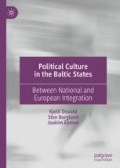Abstract
The first section of the ‘Introduction’ is devoted to the Soviet legacy of the Baltic states. The Soviet occupation was harsh, involving a radical transformation of political, economic and cultural life. Even today, staggering numbers of Estonians, Latvians and Lithuanians can report a family history of deportations, imprisonment and executions. The second section outlines the drastic demographic shift to the detriment of the majority populations, which accompanied the flow of migrant workers from Russia and other Soviet republics into the region. The chief focus of this book is on political culture, and the third section provides a snapshot of the theoretical frameworks underpinning the book, before the rest of the chapters are introduced, together with the survey data applied in the text; two of them initiated and undertaken by the book authors in 2014 and 2015.
Access this chapter
Tax calculation will be finalised at checkout
Purchases are for personal use only
Notes
- 1.
The Czech Republic and Slovakia had been part of Czechoslovakia (dissolved in 1992), and Slovenia was part of the Yugoslav Federation that broke up in 1991–1992. Croatia, another Yugoslav break-away republic, has since followed suit. It became a member of NATO in 2009 and of the EU in 2013.
- 2.
With a population of some 290 million, the Soviet Union had a nomenklatura of about 750,000, corresponding to approximately one-third of the 2.5 million administrative positions of any importance in the vast Soviet empire (Pravda 1989: 16). The small Baltic republics accounted for only a fraction of the Soviet nomenklatura ; 3400 out of 750,000 or 0.45 per cent (Matonyté and Mink 2003: 36).
References
Almond, G., & Verba, S. (1965). The Civic Culture. Boston: Little, Brown and Company.
Brazauskas, A. (1992). Lietuviškos Skyrybos/The Lithuanian Divorce. Vilnius: Politika.
Buttar, P. (2013). Between Giants: The Battle for the Baltics in World War II. Oxford: Osprey Publishing.
Courtois, S., Werth, N., Panné, J.-L., Paczkowski, A., Bartošek, K., & Margolin, J.-L. (1999). The Black Book of Communism: Crimes, Terror, Repression. Cambridge, MA: Harvard University Press.
Dellenbrant, J.-Å., & Berglund, S. (1987). The Baltic Republics: Years of Integration, 1940–1980. Åbo: Åbo Akademi, Department of Political Science, Series A: 27.
Denk, T., & Christensen, H. S. (2016). How to Classify Political Cultures: A Comparison of Three Methods of Classification. Quality and Quantity, 50, 177–191.
Denk, T., Christensen, H. S., & Berg, D. (2015). The Composition of Political Culture: A Study of 25 European Democracies. Studies in Comparative International Development, 50, 358–377.
Easton, D. (1965). A Systems Analysis of Political Life. New York, London and Sydney: John Wiley and Sons Inc.
Hay, C. (2007). Why We Hate Politics. Cambridge: Polity Press.
Hibbing, J. R., & Theiss-Morse, E. (2002). Stealth Democracy—Americans’ Beliefs About How Government Should Work. New York: Cambridge University Press.
Huntington, S. P. (1993). The Clash of Civilizations? Foreign Affairs, 72(3), 22–49.
Inglehart, R. (1997). Modernization and Postmodernization: Cultural, Economic and Political Chance in 43 Societies. Princeton: Princeton University Press.
Kasekamp, A. (2010). A History of the Baltic States. Basingstoke and New York: Palgrave Macmillan.
Küng, A. (2008). Communism in the Baltic States. Stockholm: Jarl Hjalmarson Foundation.
Matonyté, I., & Mink, G. (2003). From Nomenklatura to Competitive Elites: Communist and Post-Communist Elites. In S. Berglund & K. Duvold (Eds.), Baltic Democracy at the Crossroads: An Elite Perspective. Kristiansand: Norwegian Academic Press.
Miljan, T. (2015). Historical Dictionary of Estonia. Lanham, MD: Rowman & Littlefield.
Misiunas, R., & Taagepera, R. (1983). The Baltic States: Years of Dependence, 1940–1980. London: C. Hurst and Company.
Norris, P. (1999). The Growth of Critical Citizens. In Critical Citizens: Global Support for Democratic Governance. Oxford and New York: Oxford University Press.
Pravda, A. (Ed.). (1989). The Tauris Soviet Directory: The Elite of the USSR Today. London: I.B. Tauris & Company.
Rosanvallon, P. (2008). Counter-Democracy: Politics in the Age of Distrust. Cambridge: Cambridge University Press.
Rose, R., Berglund, S., & Munro, N. (2004). Nation States with Multi-National Populations: Cross-cutting Cleavages in the Baltic States. Centre for the Study of Public Policy, 389. University of Strathclyde.
Stoker, G. (2006). Why Politics Matters: Making Democracy Work. New York: Palgrave Macmillan.
Author information
Authors and Affiliations
Corresponding author
Rights and permissions
Copyright information
© 2020 The Author(s)
About this chapter
Cite this chapter
Duvold, K., Berglund, S., Ekman, J. (2020). Introduction. In: Political Culture in the Baltic States. Palgrave Macmillan, Cham. https://doi.org/10.1007/978-3-030-21844-7_1
Download citation
DOI: https://doi.org/10.1007/978-3-030-21844-7_1
Published:
Publisher Name: Palgrave Macmillan, Cham
Print ISBN: 978-3-030-21843-0
Online ISBN: 978-3-030-21844-7
eBook Packages: Political Science and International StudiesPolitical Science and International Studies (R0)

